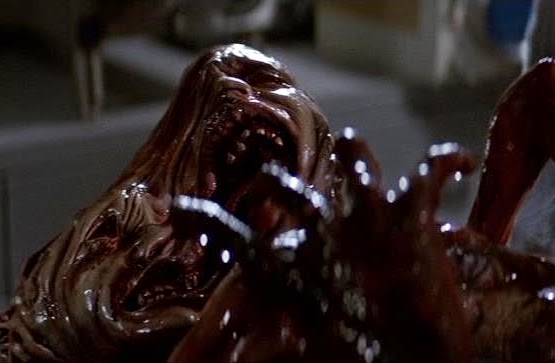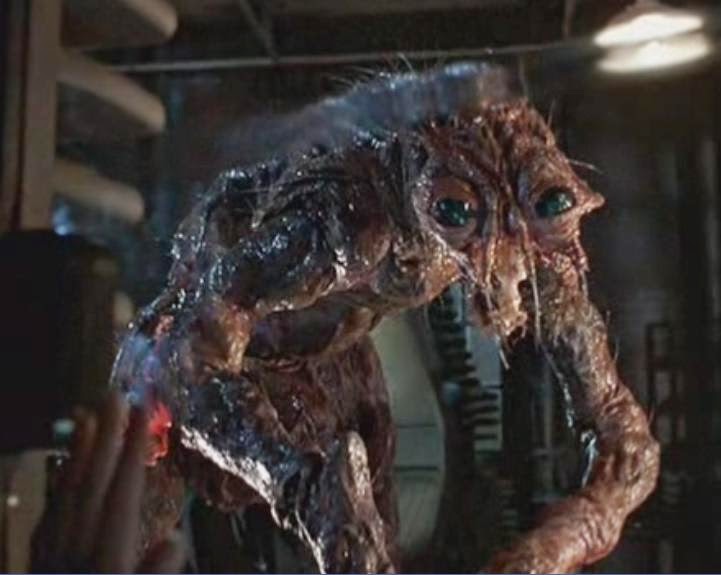If the ‘50s represented a golden age for
monster movies, then the ‘80s were a Renaissance, a rebirth of creature design,
filtered through an updated set of sensibilities. It’s easy to draw parallels between the two
decades, which exhibited their fair share of excessive fashion and Cold War
paranoia. Monsters of the ‘50s and ‘80s,
whether they originated from a foreign land or alien planet, were metaphors for
xenophobia. Outsiders were not to be
trusted. But ‘80s monsters went beyond
this paradigm, reflecting a new cynicism that criticized the authorities we
were supposed to believe in.
Monsters of the 1980s reflected the
changing demands of a more sophisticated audience, jaded by decades of rubber
monsters, and demanding something more convincing and visceral. Answering the call were a new wave of effects
masters, including Stan Winston, Rob Bottin and Rick Baker. In addition to good old man-in-suit effects
and puppetry, their bag of tricks incorporated servo-controlled animatronics
and modern lightweight materials. While some
of these methods may seem primitive by today’s standards, they took practical creature
effects to a whole new level of artistry and craftsmanship, with a
three-dimensional, flesh-and-blood quality that millions of dollars of CGI could
never equal.
No offense intended if I’ve left out one
of your favorites (feel free to comment).
You may notice the absence of Freddy Krueger and Jason Voorhees, who at
the very least deserve honorable mentions, but for reasons too arbitrary to
mention, I’ve omitted them from my list.
Without further introduction, I submit a bakers’ dozen, in no particular
order, of my favorite ‘80s monsters:
1. The Thing (TheThing, 1982) John Carpenter’s remake of the 1950s
classic The Thing from Another World was
met with indifference from mainstream audiences and dismissed by critics when
it was released in 1982. In recent
years, however, it’s climbed its way to the top of many horror/sci-fi
aficionados’ lists, thanks in no small part to Rob Bottin’s mind-blowing
effects. With his various
nightmare-inducing creations, Bottin takes us places only hinted at by the
original version. For the first time, we
witness the messy onscreen ramifications of a shape-shifting alien life form
that can become a perfect copy of anything it desires.
2. Brundlefly (The
Fly, 1986) Building on themes established by his earlier “body
horror” films (including The Brood
and Videodrome), David Cronenberg put
his inimitable spin on his remake of another 1950s classic, The Fly.
Whereas the original creature, with its human body and oversized fly
head, appears more kitschy than fearsome, the new iteration eschews the old
aesthetic to present something that’s neither man, nor insect, but an amalgamation.
After a teleporter accident combines his DNA with a housefly, scientist Seth
Brundle (Jeff Goldblum) undergoes a gradual metamorphosis that simultaneously
evokes our sympathies and revulsion. His
final form, realized by Chris Walas, underscores the potential hazards of
exploring new scientific frontiers.
3. The Stay Puft Marshmallow Man (Ghostbusters, 1984) Who knew the instrument of humanity’s destruction
could be so hilarious? Ivan Reitman’s
riff on kaiju proves that any sufficiently large monster, no matter how
ridiculous, rampaging through New York City can still elicit panic. Fear, in this case, accompanies a healthy dose
of cognitive dissonance. The late Harold
Ramis articulated it best as Egon Spengler when he said, “...I’m terrified
beyond the capacity for rational thought.”
4. Tie: Werewolves (An American Werewolf in London, 1981, and The Howling, 1981) It’s big budget versus small budget, as two effects
wizards, Rick Baker and Rob Bottin, achieve the same ends with subtly different
approaches. In a departure from earlier
incarnations of cinematic lycanthropes, which relied on time-lapse photography
and cuts, audiences for both films witnessed the painful transformation of man
to beast, through in-camera, real-time effects.
5. Gremlins (Gremlins, 1984) Cute little chatterboxes transform into malevolent
demons (No, I’m not referring to teenagers).
Joe Dante’s anarchic vision is brought to life through Chris Walas’
imaginative creations. What starts out
as one innocuous mogwai suddenly becomes hundreds of evil creatures, hell-bent with
an appetite for destruction and a penchant for watching Snow White and the Seven Dwarfs.
6. Alien Queen (Aliens, 1986) How could James Cameron, working with Stan Winston’s
creature effects crew, improve H.R. Giger’s original, elegant creature designs? He didn’t.
Instead, Cameron and his crew introduced a new, equally terrifying
monster to the Alien canon. By appropriating some of the best aspects of
Giger’s biomechanical elements and taking them to the logical conclusion for a
bigger, more powerful creature, he created something entirely new. Ever wonder what laid the giant eggs in
Alien? Wonder no more.
7. Cenobites (Hellraiser, 1987) Clive Barker introduced the world to these leather-clad
demons from a hellish nether realm.
Mortals who are foolish enough to toy with a Pandora’s Rubik’s Cube, the
puzzle box, summon the beings, who thrive on pleasure and pain (Guess which
aspect you’ll witness most?). Each
Cenobite appears in various states of mutilation, including a mute, perpetually
chattering creature, with lips cut away to reveal a set of gnashing teeth. Pinhead (Doug Bradley), known as the “Lead
Cenobite” in the first film is their de facto spokesperson, and tour guide to
hell. Sadly, his impact has become
diluted over time, on account of his subsequent appearances in the numerous,
non-Barker, sequels attempting to turn him into another wisecracking boogieman,
like Freddy or the Leprechaun.
8. Chucky (Child’s
Play, 1988) The Kevin Yagher-designed Chucky owes a debt of
gratitude to the “Living Doll” episode of The
Twilight Zone, as well as the creepy My Buddy toy of the 80s (see below)
for its inception. When dying mass murderer
Charles Lee Ray’s (Brad Dourif) soul enters a Good Guys doll, the toy comes to
life. Needless to say, when people get
in the way of Chucky, bad things happen.
Behold, this
nostalgic bit of nightmare fodder:
9. The Toxic Avenger (The Toxic Avenger, 1984) Hailed as “the first superhero from New Jersey,” the
Toxic Avenger (aka: “Toxie”) is a champion of the downtrodden citizens of
Tromaville, and underdogs everywhere. Director/co-writer/producer
Lloyd Kaufman’s enduring character has become synonymous with Troma films, and
reminds us that sometimes, the monsters are on our side.
10. “Ghouls” (They Live, 1988) To the best of my knowledge, there’s no official
name for the aliens in John Carpenter’s allegorical 1988 film, They Live, although they’re sometimes
referred to as “ghouls.” While they roam
freely among us as fellow humans, their true appearance is only revealed
through special glasses. In this case,
an invasion has already occurred, and we’re their conquest. For most of the populace, we choose to remain
in a brainwashed state, blind to the truth that resides in front of our own
eyes.
11. Killer Klowns (Killer Klowns from Outer Space, 1988) Who doesn’t like clowns? Oh yeah, just about
everyone. The comical, yet horrifying,
clown-like aliens (or “klowns”), created by the Chiodo brothers, tap into our
universal fears. They managed to distill
everything we ever disliked or suspected about clowns into these nightmarish extraterrestrial
creatures, who abduct and dine on human prey.
12. The Predator (Predator, 1987) Although this Stan Winston creation wears
dreadlocks, he’s not interested in peace, love and reggae, but collecting human
skulls as trophies. Arnold
Schwarzenegger’s Dutch finds his ultimate nemesis in the predator, played by 7-foot,
2-½ inch Kevin Peter Hall. Most
Schwarzenegger vehicles focus on his strength, but the former bodybuilder
appears puny next to his massive opponent.
13. Belial (Basket
Case, 1982) Frank Henenlotter’s tale of brotherly love stretched
to its limit features everyone’s favorite homicidal parasitic twin. Duane Bradley (Kevin Van Hentenryck) carries
his deformed twin Belial around in a basket, vowing revenge against the
physicians who separated them in an illicit surgical procedure. You might be tempted to ask, “What’s in the
basket?” Hope you never find out.




























